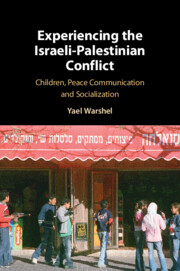Book contents
- Experiencing the Israeli-Palestinian Conflict
- Experiencing the Israeli-Palestinian Conflict
- Copyright page
- Dedication
- Contents
- Figures
- Tables
- Acknowledgments
- Note on the Text
- Abbreviations
- Introduction
- Part I The Encoding and Production of Israeli and Palestinian Sesame Street
- Part II Audience Reception of Israeli and Palestinian Sesame Street
- Part III Situating the Reception of Israeli and Palestinian Sesame Street in Mundane, Intractable Conflict Zone Practices
- Part IV Conclusions and Recommendations to Improve Peace Communication Research, (Evidence-Based) Practice and Conflict Intractability Interpretation
- Introduction to Part IV: The Best Case
- 10 Lessons Learned and Their Application to Peace Communication Research, (Evidence-Based) Practice and Conflict Intractability Interpretation
- 11 How to Improve Potential Media Effects and Impacts
- 12 Follow-Up Study of Tween-Age Former Audience Members
- Book part
- References
- Index
- Plate Section (PDF Only)
10 - Lessons Learned and Their Application to Peace Communication Research, (Evidence-Based) Practice and Conflict Intractability Interpretation
from Part IV - Conclusions and Recommendations to Improve Peace Communication Research, (Evidence-Based) Practice and Conflict Intractability Interpretation
Published online by Cambridge University Press: 08 July 2021
- Experiencing the Israeli-Palestinian Conflict
- Experiencing the Israeli-Palestinian Conflict
- Copyright page
- Dedication
- Contents
- Figures
- Tables
- Acknowledgments
- Note on the Text
- Abbreviations
- Introduction
- Part I The Encoding and Production of Israeli and Palestinian Sesame Street
- Part II Audience Reception of Israeli and Palestinian Sesame Street
- Part III Situating the Reception of Israeli and Palestinian Sesame Street in Mundane, Intractable Conflict Zone Practices
- Part IV Conclusions and Recommendations to Improve Peace Communication Research, (Evidence-Based) Practice and Conflict Intractability Interpretation
- Introduction to Part IV: The Best Case
- 10 Lessons Learned and Their Application to Peace Communication Research, (Evidence-Based) Practice and Conflict Intractability Interpretation
- 11 How to Improve Potential Media Effects and Impacts
- 12 Follow-Up Study of Tween-Age Former Audience Members
- Book part
- References
- Index
- Plate Section (PDF Only)
Summary
This chapter parses the study’s conclusions: it took only five years for these young stateless nation, state-bearing nation, and state minority audiences to become militarily, politically, economically, and socially encoded by the global interstate system. The children unwittingly replicated the violence of the conflicts surrounding them and expressed political opinions that their partners’ elimination was the sole solution. The glocal, hybrid, open and closed mediated text imagined the achievement of what each audience defined peace to be—justice of an independent Palestine; security of a safe Israel, and equality inside Israel. But it sidestepped the structural and narrative realities of the political conflicts and so could not address and change political beliefs. While communicating peacebuilding, the text did not communicate peacemaking. And even much of its peacebuilding thrust was “lost upon” audience members when they resisted the texts pro-social depictions of friendships between and among Palestinians and Israelis, in particular, between Palestinians and Jewish Israelis.
Keywords
- Type
- Chapter
- Information
- Experiencing the Israeli-Palestinian ConflictChildren, Peace Communication and Socialization, pp. 339 - 363Publisher: Cambridge University PressPrint publication year: 2021

